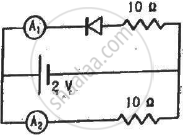Advertisements
Advertisements
प्रश्न
Consider a p-n junction diode having the characteristic \[i - i_0 ( e^{eV/kT} - 1) \text{ where } i_0 = 20\mu A\] . The diode is operated at T = 300 K . (a) Find the current through the diode when a voltage of 300 mV is applied across it in forward bias. (b) At what voltage does the current double?
उत्तर
(a) Given:-
Drift current, i0 = 20 × 10−6 A
Temperature, T = 300 K
Applied voltage, V = 300 mV
The variation in the current with respect to the voltage is given by
\[i = i_0 \left( e^\frac{eV}{KT} - 1 \right)\]
\[ \Rightarrow i = 20 \times {10}^{- 6} \left( e^\frac{0 . 3}{8 . 62 \times 300 \times {10}^{- 5}} - 1 \right)\]
\[ \Rightarrow i = 20 \times {10}^{- 5} \left( e^\frac{100}{8 . 61} - 1 \right)\]
\[ \Rightarrow i = 2 . 18 A \approx 2 \] A
(b) We need to find the voltage at which the current doubles so that the new value of the current becomes 4 A.
\[\Rightarrow 4 = 20 \times {10}^{- 6} \left( e^\frac{eV}{8 . 62 \times 3 \times {10}^{- 3}} - 1 \right)\]
\[ \Rightarrow e^\frac{V \times {10}^3}{8 . 62 \times 3} - 1 = \frac{4 \times {10}^6}{20}\]
\[ \Rightarrow e^\frac{V \times {10}^3}{8 . 62 \times 3} = 200001\]
\[ \Rightarrow \frac{V \times {10}^3}{8 . 62 \times 3} = 12 . 2060\]
\[ \Rightarrow V = \frac{12 . 206 \times 8 . 63 \times 3}{{10}^3}\]
\[ \Rightarrow V = 318 \] mV
APPEARS IN
संबंधित प्रश्न
Explain briefly with the help of necessary diagrams, the forward biasing of a p-n junction diode. Also draw characteristic curves.
Draw a circuit diagram to study the input and output characteristics of an n-p-n transistor in its common emitter configuration. Draw the typical input and output characteristics.
How is a zener diode fabricated so as to make it a special purpose diode? Draw I-V characteristics of zener diode and explain the significance of breakdown voltage.
Explain briefly, with the help of a circuit diagram, how a p-n junction diode works as a half wave rectifier.
If the two ends of a p-n junction are joined by a wire,
The diffusion current in a p-n junction is
A hole diffuses from the p-side to the n-side in a p-n junction. This means that
In a p-n junction with open ends,
(a) there is no systematic motion of charge carries
(b) holes and conduction electrons systematically go from the p-side to n-side and from the n-side to p-side respectively
(c) there is no net charge transfer between the two sides
(d) there is a constant electric field near the junction.
In a p-n junction,
(a) new holes and conduction electrons are produced continuously throughout the material
(b) new holes and conduction electrons are produced continuously throughout the material except in the depletion region
(c) holes and conduction electrons recombine continuously throughout the material
(d) holes and conduction electrons recombine continuously throughout the material except in the depletion region.
In a p.n junction, the depletion region is 400 nm wide and an electric field of 5 × 105 V m−1 exists in it. (a) Find the height of the potential barrier. (b) What should be the minimum kinetic energy of a conduction electron which can diffuse from the n-side to the p-side?
The potential barrier existing across an unbiased p-n junction is 0.2 volt. What minimum kinetic energy a hole should have to diffuse from the p-side to the n-side if (a) the junction is unbiased, (b) the junction is forward-biased at 0.1 volt and (c) the junction is reverse-biased at 0.1 volt?
When a p-n junction is reverse-biased, the current becomes almost constant at 25 µA. When it is forward-biased at 200 mV, a current of 75 µA is obtained. Find the magnitude of diffusion current when the diode is
(a) unbiased,
(b) reverse-biased at 200 mV and
(c) forward-biased at 200 mV.
The current−voltage characteristic of an ideal p-n junction diode is given by \[i = i_0 ( e^{eV/KT} - 1)\] where, the drift current i0 equals 10 µA. Take the temperature T to be 300 K. (a) Find the voltage V0 for which \[e^{eV/kT} = 100 .\]One can neglect the term 1 for voltages greater than this value. (b) Find an expression for the dynamic resistance of the diode as a function of V for V > V0. (c) Find the voltage for which the dynamic resistance is 0.2 Ω.
(Use Planck constant h = 4.14 × 10-15 eV-s, Boltzmann constant k = 8·62 × 10-5 eV/K.)
What are the readings of the ammeters A1 and A2 shown in figure. Neglect the resistance of the meters.

(Assume that the resistance of each diode is zero in forward bias and is infinity in reverse bias.)
When the base current in a transistor is changed from 30µA to 80µA, the collector current is changed from 1.0 mA to 3.5 mA. Find the current gain β.
A load resistor of 2kΩ is connected in the collector branch of an amplifier circuit using a transistor in common-emitter mode. The current gain β = 50. The input resistance of the transistor is 0.50 kΩ. If the input current is changed by 50µA. (a) by what amount does the output voltage change, (b) by what amount does the input voltage change and (c) what is the power gain?
Choose the correct option.
Current through a reverse-biased p-n junction increases abruptly at:
If in a p-n junction diode, a square input signal of 10 V is applied as shown Then the output signal across RL will be ______

Zener breakdown occurs in a p-n junction having p and n both:
During the formation of a p-n junction ______.
